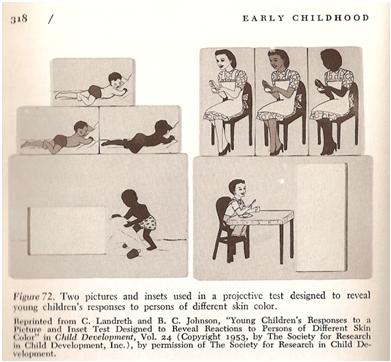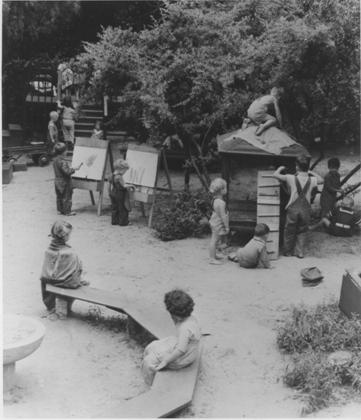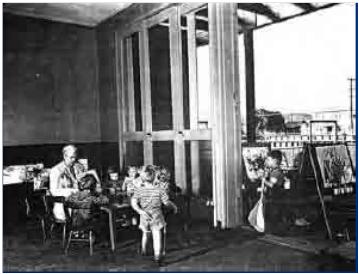Catherine Landreth is one of a small group of women who used their degree in household science as a springboard to post-graduate studies and an international academic career. Although she maintained links with household science throughout her professional life, it is Landreth’s significance as a researcher, academic and professional in the area of child development and early childhood education for which she will be remembered.
Born in 1899, she was one of three children, the daughter of primary school teachers from a rural area ten miles from Dunedin. After completing her secondary education at Otago Girls’ High School, Landreth spent a year as a pupil teacher, gained her teacher’s certificate and then enrolled in a home science degree at the University of Otago. Influenced by her Scottish Free Church antecedents, nineteenth century settler visions of New Zealand as ‘God’s own country’ and the ideals of the contemporary progressive education movement, Landreth chose home science because of its grounding in the biological sciences and its social goal of “improving society through education”.
Education

Catherine Landreth, c. 1945.
After graduating with a Bachelor of Home Science from the University of Otago Catherine taught for two years at Otago Girls High School before becoming a lecturer in home science at the Dunedin Teachers’ Training College. In 1926, through her connections in the International Federation of University Women (IFUW) she took up an American Association of University Women (AAUW) scholarship at Iowa State College completing a Masters of Science as part of their agricultural extension program. Prevented from returning to New Zealand by Otago University’s failure to fund a proposed home science extension initiative, Landreth took up a one-year appointment at Washington State College before being awarded a prestigious Laura Spelman Rockefeller Fellowship. She spent a year at Merrill Palmer Teachers’ College, Columbia University and the University of Minnesota. At Merrill Palmer’s she met director Edna Nobel White, a pioneering researcher in child development studies, who became a mentor. As Landreth recalled it, the experience proved to be “the best possible introduction to the emerging specialisation of child development”. But it was the “intellectually invigorating atmosphere of scientific enquiry” at Minnesota and the influence of John Anderson, the Director of the Institute there that inspired her to undertake post-graduate research in the field of child development in what would prove to be a life long passion. By 1932 Landreth began her PhD at the University of California in Berkeley with Dr Harold E. Jones, the Director of the Institute of Child Welfare as her advisor. In line with her developing interest in child development in the context of preschool education, Landreth’s PhD research examined factors associated with crying in young children in the nursery school and at home and tested the consistency of contemporary methods of measuring observable emotional behaviour.
Landreth’s research contribution
Catherine Landreth’s career spans more than forty years and exemplifies many of the key developments in the field of child development and early childhood education from the 1920s to the 1960s. At a time when progressive educators were increasingly turning to science to enhance their knowledge of children and their needs, she was at the forefront of attempts to improve understandings of children’s development and the conditions of infant and child care services. However, despite the significance of Landreth’s research, there is no mention of her work and only indirect references to any of the early women pioneers in child development in contemporary histories of child development. Although she is a distinguished alumnus of the School of Home Science at the University of Otago, the university archives contain only a small number of references to her. Landreth’s mentions in Home Science alumnae journals and departmental records suggest a cordial relationship with the School of Home Science renewed by her biennial visits to New Zealand to visit family and colleagues and to undertake research. An attempt in 1980 by Patricia Coleman, the then Dean of the School of Home Science to nominate Landreth for an honorary degree at Otago for Landreth’s “significant professional contribution to the field” reflects the esteem she was held in by her home science colleagues in New Zealand. Unfortunately she did not fit the University’s ‘criteria’ for an award as “virtually none of (her contribution) was in New Zealand”.
The Bancroft Library archive at the University of California, Berkeley where Catherine Landreth was appointed professor – teaching and publishing in the Home Science and psychology departments for more than forty years – has only a small file of personal letters relating to requests for leave, a handful of administrative communications and an oral history taken in 1983. The absence of a major archival collection in Landreth’s name at Berkeley is surprising given her status as an emeritus professor and her forty year association with the University of California as a pioneering researcher in the field of child development and early childhood studies.
Perhaps part of the reason for her absence from the historical record can be found in the broad range of Landreth’s research and professional interests. While other colleagues in the Institute, such as Jean MacFarlane, Harold E. Jones and Mary Cover Jones, embraced large-scale intergenerational behavioural studies such as the Oakland Study, which began in 1928-29 and still continues, Landreth’s research interests crossed diverse areas. Her early work was concerned with increasing the scientific rigour of investigations in a field that had typically been descriptive and anecdotal. Her PhD study of incidents of children’s crying, from which she published a number of articles is seminal. From the 1940s she moved into the area of social perceptions and investigations examining the place and value of the preschool in a comprehensive program of public education.

Landreth’s test of young children’s responses to skin colour (1953)
Her 1951 study of young children’s responses to persons of different colour which found that children as young as three show prejudice based on skin colour and that ethnic prejudice was related to class and level of education helped to influence the landmark Brown v. Board of Education decision in 1954 which ended segregated education for black and white students in the United States. Later studies examined children’s perception of parental role, their likes and dislikes and parents’ ability to predict their children’s responses. In 1962, for example, Landreth undertook a comparative study financed by a Fulbright Travel Award of notions of socially acceptable behaviour held by children in New Zealand and California which noted a more “relaxed attitude to sex role and sex identification” and “less emphasis on stereotypes of masculinity and femininity” in New Zealand.
Catherine Landreth’s lifelong interest in the architecture of learning and play illustrates her distinctive and sometimes idiosyncratic approach. Her pioneering ideas provided a blueprint for a number of early childhood centres including the Pullman Child Development Centre, a nursery school for the preschool children of working mothers at the Kaiser Ship Yards. Although the University of California Harold E. Jones Child Study Centre, built in 1964 stands as a memorial to the contributions of Landreth’s supervisor and boss Harold E. Jones to developmental psychology, it resulted from a collaboration between Landreth and architect Joseph Eshrick who credited her with the design ideas. In addition she authored four classic books that were influential in shaping the scope and nature of early childhood education in New Zealand and internationally. Landreth’s fascination with issues at the intersection of policy and practice led her into a range of consultative roles including a statewide survey of the social and economic factors relating to the operation of state supported child care centres in California, the findings of which were used as the basis for the funding of child-care centres for working mothers by the California state legislature.

Institute of Child Welfare Bancroft site c. 1940s. Landreth was the Director of the Nursery School at the Institute from 1938-1964
As well as her role as Director of the Nursery School, Catherine Landreth maintained a full schedule of department teaching throughout her career (the terms of her appointment were that she devote nine-tenths of her time to the department of home economics, one-tenth to the nursery school). A popular teacher, her lectures on the psychology of early childhood attracted up to 200 students from diverse programs including psychology, pre-medical, pre-nursery, social welfare, social and biological sciences. They also led to the institution of a child development major in the College of Letters and Science, providing an alternative pathway for students in the Home Economics Department who did not wish to meet the usual requirement for a chemistry major. Landreth was one of three outstanding researchers connected with the Department of Home Economics – the other two being Agnes Fay Morgan (nutrition) and Ruth Okey (biochemistry).
Gender, politics and the university
As a department established specifically for women and headed by a woman, Home Economics experienced low prestige in comparison to male-led applied fields of science at UC Berkeley. Despite the quality of its research and the successful employment of its students it struggled for research funds. A notable example of the imbalance in funding was a $US600 grant given to Home Economics from the Board of Research, which was considered a windfall until it was discovered that the chemistry department had received $US13,000 for an equivalent proposal. Key research, performed professionally by Okey, Morgan and Landreth, despite overwhelming difficulties, was seldom valued by professional associations such as the American Institute of Nutrition, the Society for Research in Child Development or by other research universities, despite their significant contributions to the fields of chemistry, nutrition and child development.
Catherine Landreth never considered herself a feminist; nor did she acknowledge that there were any difficulties with the treatment of women during her time as an academic. Always considered and discreet in response to questions about the role of women on campus, she spoke, in her oral history interview of the challenge as one of living up to the standards of excellence in teaching, research and public service. However, at a time when women constituted a minority of university staff appointments, academic women such as Landreth struggled to gain acceptance. As Joseph Esherick put it, “she was a woman and a professor, which was a problem in those days”.
-

Pullman Child Development Centre. A nursery school for the children of working mothers designed by Landreth.
By the 1950s, the field of household science itself came under threat. At a time when universities in the US were experiencing a tremendous boom, administrators sceptical of its value and embarrassed by the field’s strong vocationalism and explicit links to teacher education, increasingly disparaged household science as an academic discipline. In 1955 the academic senate at UC Berkeley voted to discontinue home economics and relocate it to a college level program on the campuses at Davis and Santa Barbara. Only the action of many hundreds of home economists in a concerted campaign of protest forced the university to compromise. As a result graduate work in nutritional sciences remained at the newly constructed Morgan Hall, while the rest of the household sciences went to Santa Barbara and Davis. The loss had serious consequences for the field of child development and early childhood education at UC Berkeley. In 1959 just as the Harold E. Jones Child Study Centre, designed by Landreth and Eshrick to meet the laboratory needs of 200 undergraduate students and an increasing number of graduate students, was completed, home economics was phased out and with it the study of child development on the Berkeley Campus.
In the end Catherine Landreth was offered the ‘chairmanship’ of the new faculty of home economics at Davis, but instead took up the offer of a professorship in the psychology department where she spent the last eighteen months of her academic career teaching and undertaking a small pilot study financed by a grant from the National Institutes of Health, exploring the “educational potential of four-year- olds through the development of educational projects”. In 1964 she retired from UC Berkeley to become involved in consultancy work for the Head Start Program, to write a curriculum guide for preschool centres and pre-kindergartens and further textbooks on child development and early childhood education, among other activities. She died at her Berkeley home in 1995 aged 95 years.
A study of Catherine Landreth’s experiences in the academy highlights both the origins of contemporary struggles and the range of strategies adopted by women as they attempted to expand their academic and professional activities. As a researcher and practitioner her career exemplifies many of the key developments in the field of child development and early childhood education. At a time when progressive educators increasingly turned to science to enhance their knowledge of children and their needs, Landreth was at the forefront of attempts to improve understandings of children’s development and the conditions of infant and child care services. She took advantage of some of the opportunities available to a new generation of women academics, and carved out a location for herself in the gendered enclave of the university.
Landreth’s absence from the historical record highlights some of the mechanisms that suppressed women’s academic and research achievements. Located in the low status enclaves of household science and early childhood education, she faced difficulties gaining credibility as an academic and access to research funding. Nevertheless, Landreth managed to carve a niche for herself as a researcher, academic and professional, undertaking seminal work in early childhood education, social attitudes, the place of the preschool in public education and the architecture of learning and play. With the grace typical of her generation, she remained optimistic about the challenges of university life and pragmatic in her responses to the difficulties she faced.
